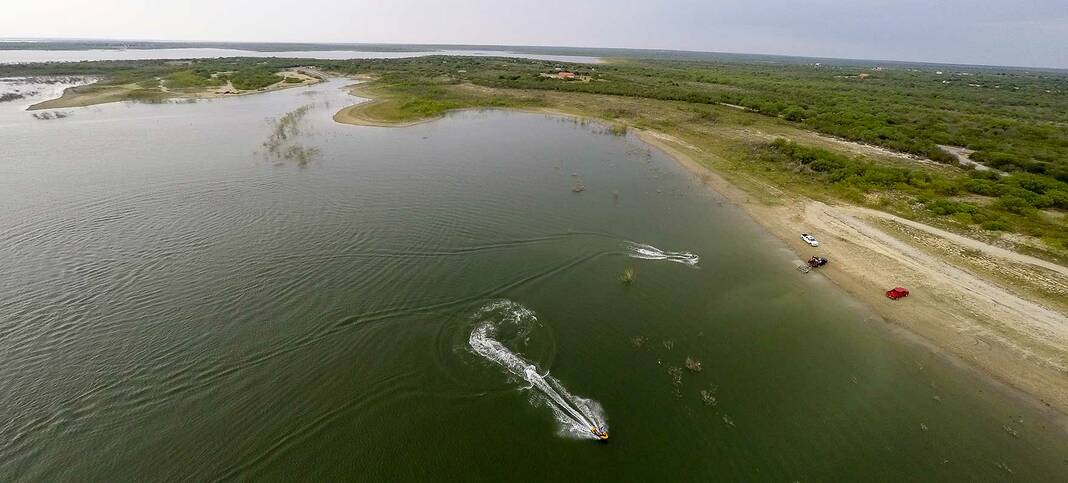Persistent drought conditions in West Texas and northern Mexico are raising concerns about water storage in the Valley’s critical two reservoirs, Amistad and Falcon.
Combined water storage in the two reservoirs, which provide drinking water and irrigation along the Rio Grande on both sides of the border, sits at just 27.32 percent of capacity.
And the trends for both reservoirs have not been good over the past year, with Amistad currently at 38.4 percent capacity, down from 51.7 percent a year ago. Likewise, Falcon sits at 19.3 percent capacity, down from 26.0 percent a year ago.
Farther upstream in the Big Bend area, almost the entire region is in extreme or exceptional drought. Particularly alarming is the news the Rio Grande has completely dried up at the monitoring station at Johnson Ranch.
“That gauging station right at the Big Bend at Johnson’s Ranch, it’s been zero for about three weeks,” said Sonny Hinojosa, general manager of Hidalgo County Irrigation District No. 2. “That’s just an indication of how dry it is over there.”
New Mexico woes
The Rio Grande has not had flows throughout the entire system for decades, and a pretty much perpetually dry riverbed stretches from Fort Quitman to Presidio.
What happens above that gap has no impact on water in the Amistad and Falcon reservoirs, but it does illustrate what is occurring in the Southwest, with half of New Mexico in exceptional drought and nearly all the rest in extreme drought.
Almost all the water in the river there is used for irrigation. Yet for the first time since the 1980s, farmers and officials in New Mexico are bracing for the Rio Grande to run dry.
“I wish I had better news for the middle valley. But what that means for irrigators, along with anybody that enjoys the river, is if we don’t get rain, this summer is going to be an extremely difficult summer, where we likely see large sections of the river drying,” Jason Casuga, chief engineer for the Middle Rio Grande Conservancy District, told KRQE News two weeks ago.
“If moisture doesn’t turn around … it’s going to be a tough two or three years,” Casuga added.
Rivers run low
Six tributaries out of northern Mexico provide almost all the water flowing into Amistad and Falcon, water which is shared with the United States by treaty.
But even these Mexican rivers are struggling with drought.
The latest data from the International Boundary and Water Commission shows that of the 14 Mexico reservoirs which provide the water for these tributaries, only three are above 50-percent capacity. The others range from 11 percent to around the mid-40s, with many at 20 to 30 percent.
“Very minimal. I tracked the NOAA (National Oceanic and Atmospheric Administration) website and it’s been dry, dry, dry,” Hinojosa said. “It’s very evident in the report that IBWC puts out on the Mexican deliveries from the six tributaries that Mexico’s deliveries have basically flat-lined.”
“You also can tell by the flows on the Conchos coming into the Rio Grande, they’ve been zero, maybe 2 to 3 feet per second, 3 cfs, that’s nothing,” he added.
Rain will help
The recent thunderstorms up and down the Valley have been a godsend, not just for residents’ lawns and farmers’ fields, but hopefully for Amistad and Falcon as well.
“I’m very anxious to see what impact the recent rains have had on our reservoirs, our water supply system,” Hinojosa said. “It has to be positive. We’re getting rain activity, which had been absent for the past couple of months.”
Hinojosa noted that given the drought conditions in the region of northern Mexico where the Rio Grande tributaries originate, it remains to be seen how much of that precipitation makes it to the reservoirs.
“You’ve got to saturate the ground first before you get the runoff,” he said.
Hinojosa is a close watcher of weather, and says the Valley region, on both sides of the border, was wetter than normal in November and December. And he said the weather forecasters were proved wrong when January and February followed suit, although March was dry.
“But luckily we’re not falling into that forecast,” he said. “Now, May-June-July, we’re back to an equal chance (of normal) precipitation, so I’m really looking forward to that, and it’s equal chance for the rest of the year for us.”
Not everyone roots for a hurricane, but in the Valley, where many areas have precipitation which averages under 30 inches a year, a weak tropical system can be just the ticket when it comes to having enough water to drink and farm.
“It’s also the start of hurricane season. You can’t forecast that,” Hinojosa said. “But that’s what we’re going to need to replenish our water supply, because Mexico just does not have the water in storage that they can give to the U.S.”
“Some kind of tropical system. And sometimes, those are the most beneficial,” he said.





